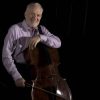- To play ricochet bowing in different rhythms and tempi.
- To practice ricochet with a variety of rhythms and bowing combinations.
- The motion of ricochet begins by swinging your upper arm in a pendulum motion and throwing your bow at the string above the middle of the bow.
- Just as a thrown ball bounces, your bow will bounce back up by itself. Don’t initially try to control the bounce.
- The wooden shaft of the bow has built-in resiliency and spring. Activate the bounce by throwing in the flexible, responsive part of the stick.
- Mastery of the stroke comes from the ability to play different rhythmic patterns, tempi, dynamics, string-crossings, and up-bow down-bow combinations.
- Once you feel comfortable with the basic elements of the stroke, improvise your practicing using all of the above-mentioned elements.
- Eliminate dirt in the sound and listen for a clear pitch and after-ring.
- The reflexive bouncing motion up out of the string contributes to the distinctive sound of this stroke.
- The articulation of ricochet is crisp, clear and alive. If your sound is dull or heavy, you are likely stopping the natural bounce of the stroke.
Cellosophy
"Feel the springiness of the ricochet vibrating within the fingers of your right hand. Get so loose that you feel you have no control at all — then you suddenly you discover you do." -Paul Katz
